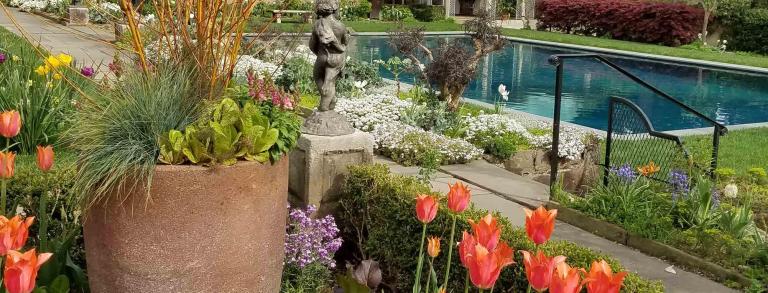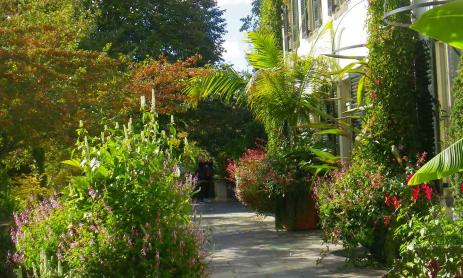IN THE DELAWARE Valley of Pennsylvania, USA (encompassing Philadelphia, Bucks County, the Brandywine Valley, and nearby areas), history and horticulture are natural partners. Many of the botanic gardens and arboreta here display the Quaker heritage of loving and studying the natural world. If you are coming to this area – say, in May for the NARGS Spring Study Weekend – plan to add a little extra time for visiting these wonderful places. Here is a brief alphabetical guide to some of them, mentioning what is open, when, and listing some of the special-interest features. Some places charge a fee, some have restricted hours, and some have photo restrictions for professionals, so it is wise to check online ahead of time. There are over thirty unique and wonderful botanical gardens and arboreta within thirty miles (48 km) of Philadelphia.
Awbury Arboretum
Francis Cope House
One Awbury Road Philadelphia, PA 19138 215-849-2855 www.awbury.com
Awbury Arboretum is a 19th-century Quaker estate with several homes on 55 acres (22 hectares) which have been designed in the English landscape tradition. Over 200 species of mature trees and lovely gardens, ponds, and woodland trails are features. Open daily dawn to dusk. Admission is free.
The Barnes Foundation Arboretum
300 North Latches Lane
Merion, PA 19066
610-667-0290 www.barnesfoundation.org
Before the Barnes Foundation art museum was relocated to the Parkway downtown, it was located on the Main Line at the Albert C. Barnes residence and 12-acre (5-hectare) arboretum. The arboretum, founded by Laura Barnes before 1928, boasts over 2,500 varieties of woody plants and perennials. The peony and lilac collections date back to the early 1900s, and the herbarium, established in 1968, contains more than 10,000 specimens. There’s also a garden of medicinal plants, a collection of magnolias, grand stonework, and a huge stone trough. The arboretum is open for public visits on Saturdays and Sundays, from 11 a.m. to 4 p.m., through early September. Admission fees are charged.
Bartram’s Garden
5400 Lindbergh Boulevard
(54th Street and Lindbergh Boulevard) Philadelphia, PA 19143
215-729-5281 www.bartramsgarden.org
In Philadelphia along the Schuylkill River, is the colonial stone home of the Bartram family, part of a 45-acre (18-hectare) National Historic Landmark. There is also a stone grinding wheel from back in the day, orderly plantings of a botanist’s collection, plus a wildflower meadow, river trail, wetland, and farm buildings. Billed as “America’s oldest living botanical garden,” it was started in 1728 by Quaker farmer and self-taught botanist John Bartram (1699-1777), who collected and shared the then unknown and exotic North American wild plants. He tried to document the New World’s native flora. He traded cuttings, seeds, and information with fellow farmers Thomas Jefferson and George Washington, among others, and eventually was named Royal Botanist to King George III. His son William Bartram (1739-1823) became a well-known botanist and author as well. The grounds are open to the public every day and are free to visit. Fees are charged for house tours and special events.
Chanticleer
786 Church Road
Wayne, PA 19087
610-687-4163 www.chanticleergardens.org
On the Main Line in Wayne, Pennsylvania, Chanticleer is the former residence of Adolph Rosengarten, Jr., who was famous as a code breaker in WWII. He set up the estate to become a trust and open space. After engaging British horticulturist Chris Woods to design and maintain it, their mission was to make it a pleasure garden. After Woods left, R. William (Bill) Thomas took over Chanticleer’s management and design, bringing out ideas from a talented staff and also working with them on the award-winning book, The Art of Gardening: Design, Inspiration, and Innovative Planting Techniques from Chanticleer.
Romantic Chanticleer features marvelously flowing plantings and extensive gardens of flowering trees, native plants, hardy perennials and unusual annuals, tropical plants, planters and window boxes, a cut flower garden, a fenced vegetable garden, and more. A woodland garden walk leads to a water garden surrounded by grasses and herbs. The Ruin Garden with its sculptures and flat stone table fountain abuts a gravel garden of special interest to rock gardeners. Though garden plants seem to be unlabeled, plant lists are available in artisan-created boxes. Talking to the gardeners responsible for the various locations is part of the fun of visiting. The garden is open to the public from early April to early November, Wednesday through Sunday. Fees are charged.
The Henry Foundation for Botanical Research
801 Stony Lane
Gladwyne, PA 19035
610-525-2037 www.henrybotanicalgarden.org
The Henry Foundation is the former home of plant explorer Mary Gibson Henry (1884-1967). Its design is naturalistic, with appropriate settings for wild plants from many diverse regions. Encompassing hills and woodlands, the serene location is a tribute to this inspiring botanist and gardener. Mary Henry’s rock garden is being restored. The home serves as a meeting place for many horticultural lectures and special events, and also serves as a library. To visit, call the garden or sign up on the website.
Jenkins Arboretum
631 Berwyn Baptist Road
Devon, PA 19333
610-647-8870 www.jenkinsarboretum.org
Jenkins Arboretum is known for its magnificent collection of native and hybrid azaleas and rhododendrons, native plant collection, and, more recently, its environmentally significant headquarters. With many levels and angles and lots of glass, the John J. Willamon Education Center aims to bring the outdoors inside. It gives a bit of the appearance of a tree house, though it is much larger. It is a gold level LEED (Leadership in Energy and Environmental Design) certified building. Jenkins hosts horticultural talks and meetings, contains an art gallery, and sponsors horticultural events, while the wooded grounds contain miles of trails, a stream and pond, and rare shrubs and trees. Admission is free, and the arboretum is open from dawn to dusk daily.
Longwood Gardens
1001 Longwood Road
Kennett Square, PA 19348
610-388-1000 www.longwoodgardens.org
One of the world’s leading horticultural gardens, Longwood Gardens is situated on 1,050 acres (425 hectares) and offers sights and services that should not be missed by any visitor to this region. It was created by industrialist Pierre S. Dupont (1870-1954) who bought a farm and then over many years turned it into the astonishing garden and center of horticulture that we can see today. Longwood features wild areas and a massive conservatory, naturalistic regions of native plants and garden plants from all parts of the world. There are water features, ponds, 20 different outdoor gardens, woodland gardens, and meadows. Longwood is committed to professional and amateur horticultural education with special facilities for both. Special collections of plants are of interest to rock gardeners. Longwood also has spectacular fountains and offers concerts, organ and carillon recitals, musical theater, and fireworks displays. Longwood is open every day of the year and attracts more than 900,000 annual visitors from around the world. Fees are charged
100 Northwestern Avenue
Philadelphia, PA 19118
215-247-5777 www.morrisarboretum.org
Morris Arboretum, the arboretum of the University of Pennsylvania, is also an educational center supporting plant exploration, classes, and lectures. The 92-acre (37-hectare) arboretum includes many of Philadelphia’s largest and rarest trees. Garden
areas include a rose garden, the Pennock flower walk, a glassed-in fernery built in 1899, the Oak Allee, the Azalea Walk, the Swan Pond, the Japanese Hill and Water Garden, the English Park, the Sculpture Garden, the Magnolia Slope, an extensive wetland, and the Ha-Ha
Wall with sides planted in wonderful rock garden specimens. For young people, there is a wonderful treehouse playground and a garden railway. Fees are charged.
Mt. Cuba Center
Woodland plantings of native plants at Mt. Cuba Center.
3120 Barley Mill Road
Hockessin, DE 19707
302-239-4244 www.mtcubacenter.org
Mt. Cuba’s emphasis is gardening with Appalachian native plants and inspiring others to do likewise, and to protect the habitats that sustain them. In this rural complex set on many acres are many areas of interest. There is an extensive rock garden on the entrance lane. The Main House, formerly the home of the Copeland family, looks out on a magnificent view of the fields and forests of the area. It has a formal garden with paths that lead on to a trial garden for evaluating native plants. This leads to a path through woodlands enhanced with native plants, leading down to a lovely pond and garden with primroses and a bog garden. Then walking upward one goes through the Dogwood Path and Meadow. But do not miss the wonderful trillium garden and the Woods Path with its columns of tree trunks making a special effect.
Scott Arboretum of Swarthmore College
500 College Avenue, Swarthmore, PA 19081 619-328-8025 www.scottarboretum.org
The grounds of Swarthmore College, a Quaker institution, are also the location of historic Scott Arboretum. Featuring over 4,000 kinds
of ornamental plants, it displays some of the best ones for use in the Delaware Valley region. The arboretum has a center in and around
its unique building, with attractive plantings of trees, perennials, and containers, but its special plantings are spread throughout the campus. In spring the huge collection of rare bulbs, native plants, and flowering cherry trees is world class, but in fall the massive ornamental planters come into their own. Special horticultural lectures, programs, and plant sales are held frequently. This campus arboretum is open daily and is free to visit.
The Tyler Arboretum
515 Painter Road
Media, PA 19063
610-566-9134 www.tylerarboretum.org
The Tyler Arboretum is another site which stems from Quaker origins. It is one of the oldest and largest arboretums in the Northeast, encompassing 650 tranquil acres (263 hectares) of horticultural collections, rare specimens, ancient trees, a herb garden, historic buildings, and extensive hiking trails. Highlights include an 85-acre (34-hectare) pinetum, the Stopford Family meadow maze filled with daffodils, Pink Hill, and 20 miles (32 km) of trails through wild areas. In late spring, be sure to check out the blooming azaleas, hydrangeas, rhododendrons, and bottlebrush buckeye. Future plans include using 50 acres (20 hectares) for heritage seed growing and saving by William Woys Weaver. It is open daily at 9 am, and fees are charged.
Winterthur
5105 Kennett Pike
Winterthur, DE 19735 302-888-4600 www.winterthur.org
Winterthur Museum, Garden, and Library, founded by Henry Francis du Pont, is an important cultural site. Esthetics were of primary significance to him. The museum’s collection of American decorative arts is known for scholarship and historical interest. The grounds
were designed to include thousands of colorful bulbs and masses of gorgeous plants yet look naturalistic and harmonious, with one large spread feeding seamlessly into the next. When visiting, you can take a tram ride or have a self-guided walk to see it all. It is an unforgettable experience to walk through eight acres (3 hectares) of mature and rare azaleas and rhododendrons, all in bloom. Visitors also enjoy the Sundial Garden, a reflecting pool and ponds, and a three-acre (1.2-hectare) children's garden called the Enchanted Woods, complete with a thatched stone cottage just the right size for small people to enjoy. The garden is open from 9 am to dusk daily and noon to dusk on Sundays. A fee is charged.


